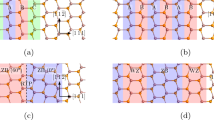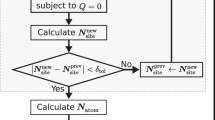Abstract
We present a holistic method to identify stable point defects in InP and the position of their defect states within the experimental band gap using density functional theory. We have calculated the formation energy of the different charge neutral native point defects for both stoichiometric and non-stoichiometric InP by determining the chemical potentials of In and P within the compound correctly from thermodynamic considerations. For stoichiometric InP, we predict phosphorous vacancies and phosphorus antisites to be most probable, among the neutral defects. For In-rich and P-rich compositions, we find indium and phosphorous antisites to be most stable, respectively, when neglecting charges. We then present a careful analysis to identify the defect levels associated with each point defect within the experimental band gap and compare it with existing experiments. By comparing calculations with different cell sizes and with varying band gaps from different exchange–correlation functionals (GGA vs. hybrid functional), we examine the dependence of the defect states on cell size and position of the excited states and analyze their nature and expected position in real systems along with the resulting charges on the defects. Finally, we include a recipe to approximate the Fermi level dependence of the chemical potential of charged defects in binary compounds, allowing calculation of their formation energies. Considering charges, the dominant point defects for stoichiometric InP are +4 and +2 charged indium and phosphorous antisites for Fermi energies <0.4 eV, +1 and +2 charged phosphorous vacancies and antisites for Fermi energies between 0.4 eV and 0.9 eV, +1 and −3 charged indium and phosphorous vacancies between 0.9 and 1.1 eV and −3 and −2 charged indium vacancies and antisites for Fermi energies >1.1 eV, respectively. For non-stoichiometric InP, the respective antisites are constitutional defects in their minimum-energy charge states, depending on the Fermi level.













Similar content being viewed by others
References
Beling A, Campbell JC (2009) J Lightweight Technol 27(3):343
Mokkapati S, Jagadish C (2009) Mater Today 12(4):22
Ko D, Zhao XW, Reddy KM, Restrepo OD, Mishra R, Beloborodov IS, Trivedi N, Padture NP, Windl W, Yang FY, Johnston-Halperin E (2011) arXiv:1106.4492
Kennedy TA, Wilsey ND (1984) Appl Phys Lett 44(11):1089
Jeon DY, Gislason HP, Donegan JF, Watkins GD (1987) Phys Rev B 36(2):1324
Deiri M, Kanaah A, Cavenett BC, Kennedy TA, Wilsey ND (1988) Semicond Sci Technol 3(7):706
Kuriyama K, Sakai K, Okada M, Yokoyama K (1995) Phys Rev B 52(20):14578
Korshunov FP, Radautsan SI, Sobolev NA, Tiginyanu IM, Ursaki VV, Kudryavtseva EA (1989) Sov Phys Semicond 23(9):980
Korshunov FP, Radautsan SI, Sobolev NA, Tiginyanu IM, Kudryavtseva EA, Ursu VA, Tsyplenkov IN, Lamm VN, Sheraukhov VA (1990) Sov Phys Semicond 24(11):1263
Zhao Y, Dong Z, Miao S, Deng A, Yang J, Wang B (2006) J Appl Phys 100:123519
Janardhanam V, Kumar AA, Reddy VR, Choi CJ (2011) Microelectron Eng 88:506
Bretagnon T, Dannefaer S, Kerr D (1993) J Appl Phys 73(9):4697
Dannefaer S, Bretagnon T, Kerr D (1996) J Appl Phys 80(7):3750
von Bardeleben HJ (1986) Solid State Commun 57:137
Guha S, Hasegawa F (1976) Solid State Electron 20:27
Janardhanam V, Kumar AA, Reddy VR, Reddy PN (2010) J Mater Sci: Mater Electron 21:285
Jansen RW (1990) Phys Rev B 41(11):7666
Caldas MJ, Dabrowski J, Fazzio A, Scheffler M (1990) Phys Rev Lett 65(16):2046
Alatalo M, Nieminen RM, Puska MJ, Seitsonen AP, Virkunnen R (1993) Phys Rev B 47(11):6381
Seitsonen AP, Virkkunen R, Puska MJ, Nieminen RM (1994) Phys Rev B 49(9):5253
Schmidt TM, Miwa RH, Fazzio A, Mota R (1999) Phys B 273–274:831
Schmidt TM, Miwa RH, Fazzio A, Mota R (1999) Phys Rev B 60(24):16475
Castleton CWM, Mirbt S (2003) Phys B 340–342:407
Castleton CWM, Mirbt S (2004) Phys Rev B 70:195202
Castleton CWM, Höglund A, Mirbt S (2006) Phys Rev B 73:035215
Höglund A, Castleton CWM, Göthelid M, Johansson B, Mirbt S (2006) Phys Rev B 74:075332
Castleton CWM, Höglund A, Mirbt S (2009) Model Simulat Mater Sci Eng 17:084003
Hagen M, Finnis MW (1998) Philos Mag A 77:447
Sen D, Windl W (2007) J Comp Theoret Nanosci 4:1
Mishra R, Restrepo OD, Woodward PM, Windl W (2010) Chem Mater 22:6092
Mayer J, Elsässer C, Fähnle M (1995) Phys Status Solidi B 191:283
Perdew JP, Wang Y (1992) Phys Rev B 45:13244
Heyd J, Scuserial GE, Ernzerhof M (2003) J Chem Phys 118:8207
Heyd J, Scuserial GE, Ernzerhof M (2006) J Chem Phys 124:219906
Paier J, Marsman M, Hummer K, Kresse G, Gerber IC, Angyan JG (2006) J Chem Phys 124:154709
Mishra R, Restrepo OD, Rajan S, Windl W (2011) Appl Phys Lett 98:232114
Alkauskas A, Broqvist P, Pasquarello A (2011) Phys Status Solidi B 248:775
Monkhorst HJ, Pack JD (1976) Phys Rev B 13:5188
Blöchl PE, Jepsen O, Andersen OK (1994) Phys Rev B 49:16223
Kresse G, Hafner J (1993) Phys Rev B 47:558
Kresse G, Hafner J (1994) Phys Rev B 49:14251
Vanderbilt D (1990) Phys Rev B 41:R7892
Blöchl PE (1994) Phys Rev B 50:17953
Perdew JP, Burke K, Ernzerhof M (1996) Phys Rev Lett 77:3865
Perdew JP, Burke K, Ernzerhof M (1997) Phys Rev Lett 78:1396
Zhang SB, Northrup JE (1991) Phys Rev Lett 67(17):2339
Torpo L, Marlo M, Staab TEM, Nieminen RM (2001) J Phys 13:6203
Gao F, Weber WJ, Xiao HY, Zu XT (2009) Nucl Instr Meth Phy Res B 267:2995
Daw MS, Windl W, Carlson NN, Laudon M, Masquelier MP (2001) Phys Rev B 64:045205
Batista ER, Heyd J, Hennig RG, Uberuaga BP, Martin RL, Scuseria GE, Umrigar CJ, Wilkins JW (2006) Phys Rev B 74:121102
Vurgaftman I, Meyer JR, Ram-Mohan LR (2001) J Appl Phys 89:5815
Windl W, Bunea MM, Stumpf M, Dunham ST, Masquelier MP (1999) Phys Rev Lett 83:4345
Windl W (2004) Phys Status Solidi B 241:2313
Windl W, Sankey OF, Menéndez J (1998) Phys Rev B 57:2431
Hjalmarson HP, Vogl P, Wolford DJ, Dow JD (1980) Phys Rev Lett 44:810
Acknowledgements
We would like to acknowledge the Center for Emergent Materials at The Ohio State University, an NSF MRSEC (Grant No. DMR-0820414) for providing funding for this research. We further acknowledge partial support from the Institute for Materials Research at OSU and the DOE-NEUP program (project number CFP-09-842). Computer calculations were performed at the Ohio Supercomputer Center under Grant No. PAS0072.
Author information
Authors and Affiliations
Corresponding author
Rights and permissions
About this article
Cite this article
Mishra, R., Restrepo, O.D., Kumar, A. et al. Native point defects in binary InP semiconductors. J Mater Sci 47, 7482–7497 (2012). https://doi.org/10.1007/s10853-012-6595-8
Received:
Accepted:
Published:
Issue Date:
DOI: https://doi.org/10.1007/s10853-012-6595-8




